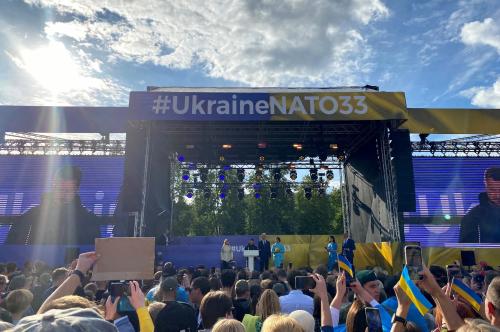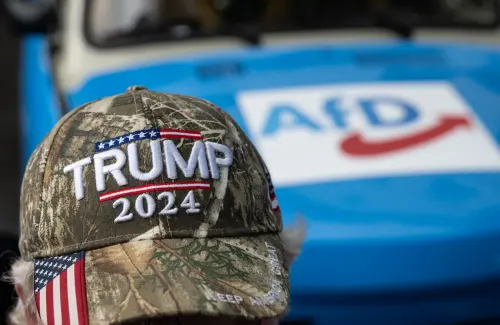In 1948, President Harry Truman was on the ropes. He was personally unpopular and faced breakaway candidates to his left (former Vice President Henry Wallace, running as the head of the Progressive Party) and to his right (the Dixiecrats, headed by Strom Thurmond). Although Truman lost 2.4% of the popular vote and 39 electoral votes to Thurmond and another 2.4% of the vote to Wallace, he managed to beat Republican Thomas Dewey by 49.6% to 45.1% (4.5 percentage points).
The story of the 2024 presidential campaign could be a rerun of 1948 — with a different ending. As in 1948, an unpopular incumbent Democratic president may well face Democratic defections to his left and his right. A leading Black public intellectual, Cornel West, will be filling Henry Wallace’s slot as the presidential nominee of the Green Party. To Joe Biden’s right, No Labels is threatening to run an “independent bipartisan” ticket that could be headed by centrists such as Larry Hogan, the former never-Trump Republican governor of Maryland; Joe Manchin, the moderate Democratic senator from West Virginia; or Arizona’s independent senator, Kyrsten Sinema.
It is much too early to assess the impact of this dual threat, but the early signs are not encouraging for Biden. A recent poll by Echelon Insights, a Republican-leaning survey research firm, found that while Biden would narrowly defeat Donald Trump in a rematch of their 2020 contest, Cornel West would receive 4% of the vote in a three-way race, giving the edge to Trump. West would draw about three-quarters of his support from potential Biden voters, especially Blacks, young people, and voters with graduate degrees.
Meanwhile, a poll by Data for Progress suggested that a centrist independent candidacy would also hurt President Biden more than former President Trump. Like Echelon Insights and other polling firms, Data for Progress found that Biden would defeat Trump in a closely contested two-way race. But in a three-way race featuring Trump, Biden, and an unnamed “moderate Independent candidate,” Trump would come out on top, because the third choice would draw 6 percentage points from Biden’s support versus 3 points from Trump. Otherwise put, in a two-way race, 41% of the potential supporters of a moderate independent choice would support Biden, compared to just 24% who would opt for Trump.
It is very early in the race, of course, so these findings should be read with a healthy pinch of skepticism. Still, they suggest that a four-way race might not go as well for Joe Biden in 2024 as it did for Truman in 1948. The difference, I would suggest, is the baseline balance between the two major parties. In 1944, Democrats were on a roll. In that election, Franklin D. Roosevelt defeated Thomas Dewey by 7.5 percentage points, 53.4% to 45.9%. The Republicans nominated Dewey a second time in 1948, and the Republican candidate ended up with roughly the same share of the popular vote as he had four years earlier. Truman could afford to lose almost 5% of the baseline Democratic vote to breakaway candidates to his left and right and still prevail. Still, it was a narrow victory. If Dewey had done 1 percentage point better in the popular vote, he probably would have won three large states — Ohio, Illinois, and California — that he lost by less than 1 percentage point, allowing him to win a majority in the Electoral College despite losing to Truman in the popular vote.
By contrast, Joe Biden begins with a narrower advantage in what I am calling the “baseline” vote. In 2020, when just about everything went right for him, he defeated Trump by 51.3% to 46.8% (4.5 percentage points) in the popular vote. Because Biden’s baseline edge is 3 percentage points lower than Truman’s, he cannot prevail with losses to his left and right as large as those Truman experienced. If a four-way election were held tomorrow, Biden would probably lose.
Fortunately for the incumbent, the election will not occur for another 16 months. As often happens with new Third-Party possibilities, Cornel West’s 4% showing in the Echelon Insights poll may well prove to be a high-water mark. Running on the Green Party ticket in 2016, Jill Stein received just 1.1% of the popular vote. And notably, when the Data for Progress poll replaced the generic No Labels candidate with an actual candidate (Larry Hogan), support for the moderate independent option fell by more than half.
Still, Joe Biden’s room for maneuver is dangerously small. Even though Stein received just over 1% of the vote in 2016, her vote total was higher than Trump’s margin of victory in three key states — Michigan, Pennsylvania, and Wisconsin — with enough electoral votes to turn Hillary Clinton’s defeat into a narrow victory. Although we cannot say for sure that Stein cost Clinton the election, we cannot rule out the possibility that she did.
Even though Biden gained a healthy popular vote victory in 2020, a shift of a handful of votes in three states — Georgia, Arizona, and Wisconsin — would have created a 269-269 tie in the Electoral College, throwing the election into the House of Representatives, where Trump would have prevailed. If Cornel West ends up with even half of his current support, he will double Stein’s share, imperiling Biden’s reelection chances. If a No Labels candidate were also in the race, the hill Biden must climb would be even steeper.
The Brookings Institution is committed to quality, independence, and impact.
We are supported by a diverse array of funders. In line with our values and policies, each Brookings publication represents the sole views of its author(s).








Commentary
Will Cornel West turn the 2024 presidential election into a rerun of 1948?
July 13, 2023